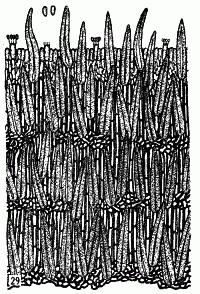|
 Hymenochaete vallata Hymenochaete vallata
BiostatusPresent in region - Indigenous. Non endemic
Images (click to enlarge)
Caption: FIG. 29. Hymenochaete vallata G.H.Cunn. Transverse section x 500; spores x 1000. |
Article: Cunningham, G.H. (1957). Thelephoraceae of New Zealand. XIV. The genus Hymenochaete. Transactions of the Royal Society of New Zealand 85(1): 1-51.
Description: Hymenophore resupinate, annual or biennial, membranous, adnate, effused forming linear
areas 5-25 x 1-2.5 cm, following closely the contours of the substratum. Hymenial surface at
first olivaceous, soon sepia or chocolate, colliculose, velutinate, at length deeply areolately
creviced; margin thinning out, fulvous or concolorous; fibrillose, adnate. Context sepia, 100-260 µ thick,
composed of numerous overlapping irregular rows of setae, sometimes arranged
in strata with cemented compacted parallel hyphae between, embedded in upright hyphae,
arising from a narrow basal, cemented, intertwined zone; hyphal system dimitic; skeletal
hyphae 2.5-3 µ diameter, walls 1 µ thick, yellow brown, sparsely branched, septate;
generative hyphae 2-2.5 µ diameter, walls 0.2 µ thick, hyaline, branched, septate. Setae
projecting to 25 µ, subulate, crowded, 30-60 x 6-8 µ, walls reddish-brown, finely verruculose
on apices, with narrow lumina. Hymenial layer a dense palisade of basidia and paraphyses.
Basidia subcylindrical, 12-18 x 4-4.5 µ, 4-spored; sterigmata erect, slender, to 5 µ long.
Paraphyses cylindrical, shorter and narrower than the basidia. Spores suballantoid, 3.5-4 x
1.5-2 µ, walls smooth, hyaline, 0.1 µ thick.
Habitat: HABITAT: Effused on bark and decorticated dead branches associated with a white rot.
Distribution: DISTRIBUTION: New Zealand.
Notes: Characters of the species are the small setae crowded into overlapping rows occupying the
entire context, suballantoid small spores, small cylindrical basidia, and effused adnate
fructifications with sepia or chocolate colliculose surface. At first fructifications are
olivaceous with fulvous margins; they soon change to sepia or chocolate with concolorous
margins. Finally plants become deeply areolately creviced,. and may peel away in segments
from the substratum. Sometimes a second stratum develops upon a preceding season's
fructification. Setae are usually arranged in overlapping rows embedded in scanty erect
hyphae. Sometimes definite strata are visible, each setal layer then arising from an interrupted
zone of compacted, intertwined and cemented hyphae. Spores are small, suballantoid and
basidia slender and almost cylindrical.
Most closely resembling H. magnahyphae, the species may be separated by the dimitic hyphal
system, much smaller spores and basidia, narrower hyphae and larger setae.
|